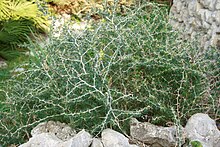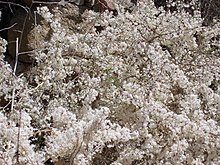Asparagus albus is a widespread species of flowering plant in the family Asparagaceae, native to the western and central Mediterranean.[2] It is found in the coastal maquis shrubland biome, and in ruderal situations.[1]
| Asparagus albus | |
|---|---|

| |
| Stems are white | |

| |
| Flowers are white | |
| Scientific classification | |
| Kingdom: | Plantae |
| Clade: | Tracheophytes |
| Clade: | Angiosperms |
| Clade: | Monocots |
| Order: | Asparagales |
| Family: | Asparagaceae |
| Subfamily: | Asparagoideae |
| Genus: | Asparagus |
| Species: | A. albus
|
| Binomial name | |
| Asparagus albus | |
| Synonyms[2] | |
| |
Taxonomy
editAsparagus albus was formally described in 1753 by the Swedish naturalist Carl Linnaeus in the first volume of his Species Plantarum under its current binomial name.[3][4] The specific epithet, albus, is Latin meaning "white".[5]
References
edit- ^ a b Véla, E. (2018). "Espárrago Asparagus albus". IUCN Red List of Threatened Species. 2018: e.T176528A21326698. doi:10.2305/IUCN.UK.2018-2.RLTS.T176528A21326698.en. Retrieved 25 April 2023.
- ^ a b "Asparagus albus L." Plants of the World Online. Royal Botanic Gardens, Kew. Retrieved 25 April 2023.
- ^ Linnaeus, Carl (1753). Species plantarum : exhibentes plantas rite cognitas ad genera relatas, cum diferentiis specificis, nominibus trivialibus, synonymis selectis, locis natalibus, secundum systema sexuale digestas (in Latin). Vol. 1. Holmiae [Stockholm]: Impensis Laurentii Salvii. p. 314.
- ^ "Asparagus albus L." International Plant Names Index (IPNI). Royal Botanic Gardens, Kew, Harvard University Herbaria & Libraries and Australian National Herbarium. Retrieved 15 May 2024.
- ^ Simpson, Donald Penistan, ed. (1977). "albus". Cassell's Latin Dictionary : Latin-English, English-Latin (5th ed.). New York: Macmillan. p. 33. ISBN 0-02-522570-7.
